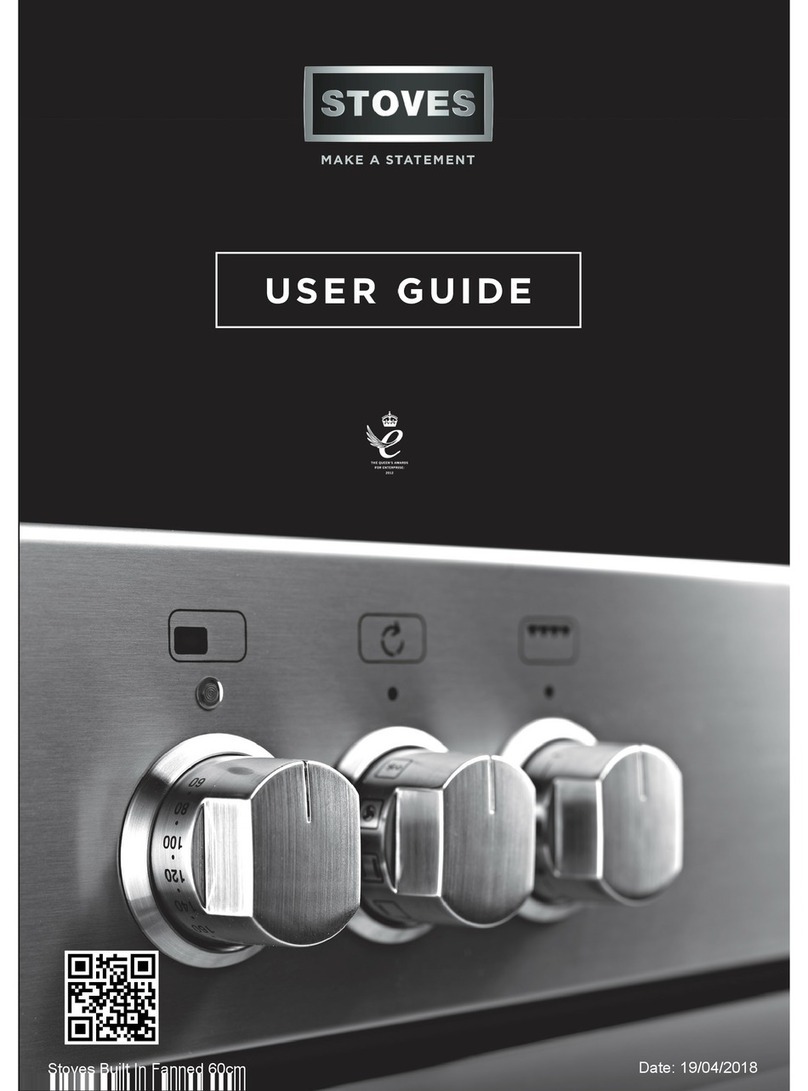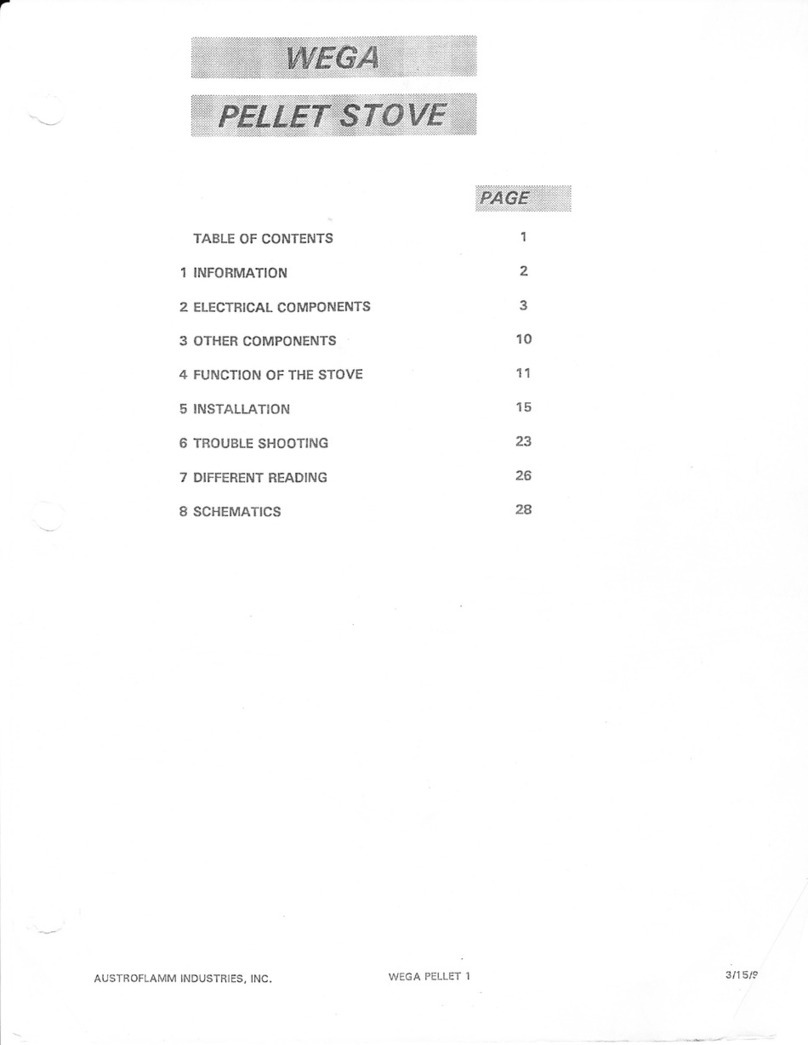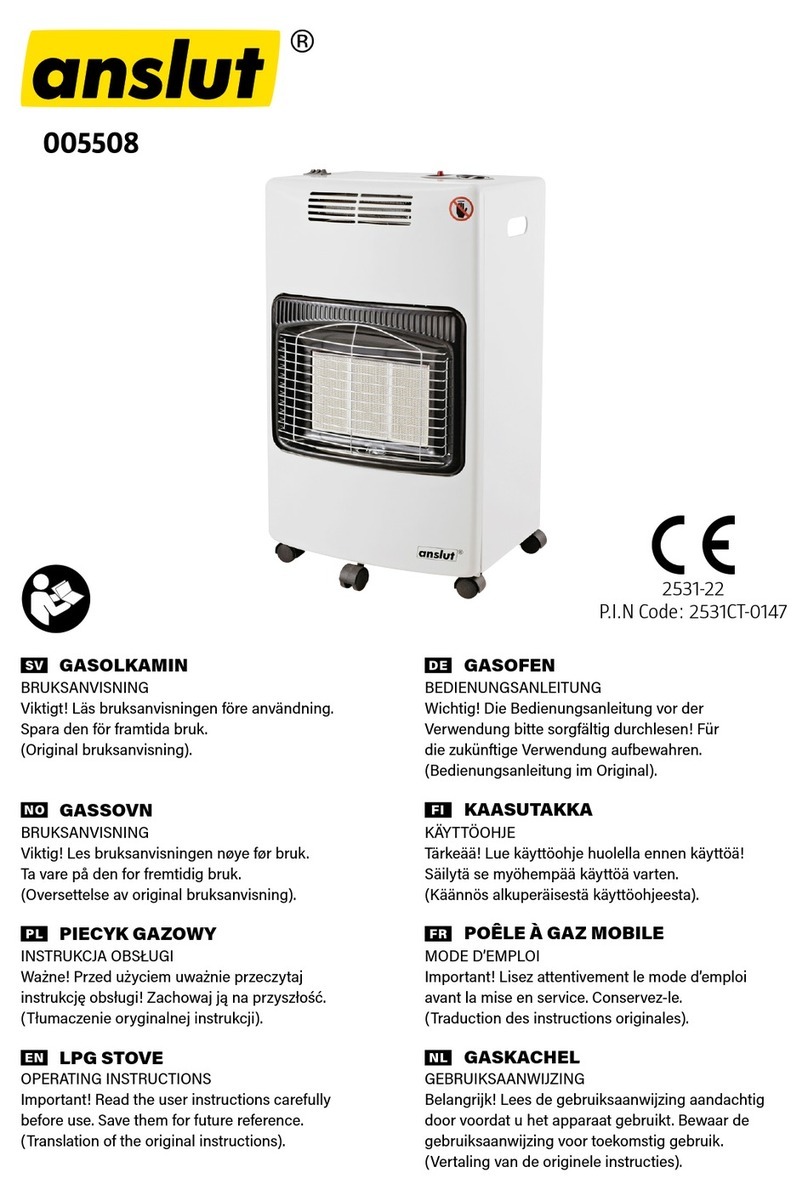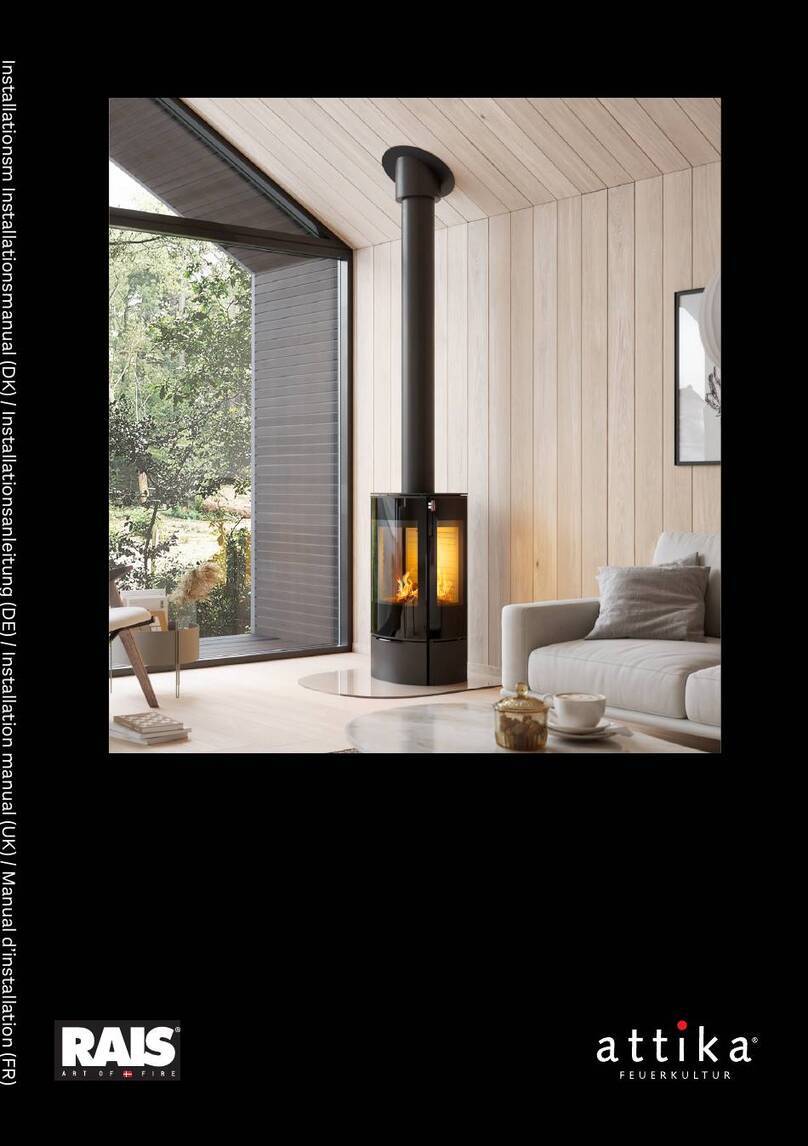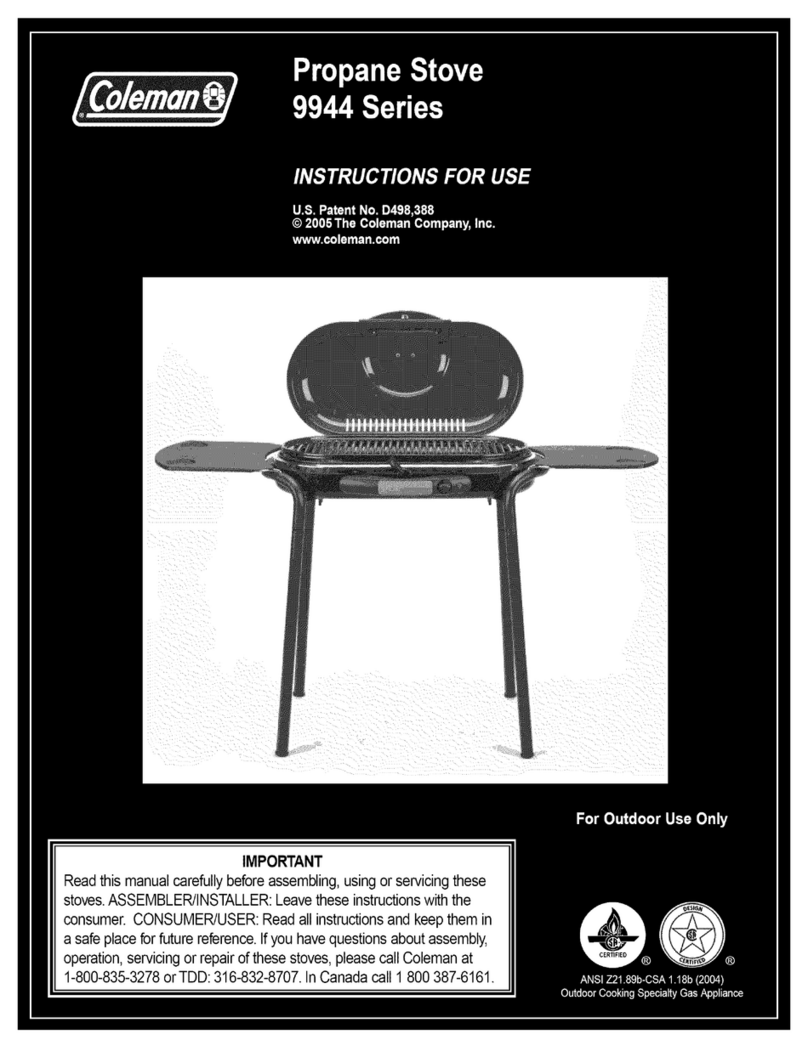Flavel Arundel MK2 User manual

Arundel M 2
Multi-Fuel Stove, Model No. FCMSB2
Installation and Operating Instructions
Read these Instructions and
use only the recommended fuels
Leave this manual with the householder
following installation
o find a qualified installer, fuel supplier or chimney sweep please contact :-
UK - he Solid Fuel Association R.O.I. - Irish Nationwide Fireplace Organisation
7 Swanwick Court 162 Capel Street
Alfreton Dublin
Derbyshire el (01) 801 5959
DE55 7AS www.fireplace.ie
el : (0845) 601 4406
www.solidfuel.co.uk
his Flavel Arundel MK2 Stove may be used in smoke control areas when operated strictly
in accordance with these instructions and with Soliftec Smoke Advice Sheet No. 1
(www.soliftec.com/smokeadvice.htm) when burning :
UK : Untreated wood logs or authorised smokeless fuels (exempted from s20 of the clean
air act 1993)
ROI : Wood logs, smokeless fuels or peat briquettes, but not petroleum coke (Control of
Atmospheric Pollution Regulations, 1970)
Page 1 of 18

Information Requirements for Commission Regulation (EU) 2015/1186
odel Identifier FC BS2
Indirect Heating Functionality No
Direct Heat Output 4.9kW
Indirect Heat Output Not Applicable
Fuel Wood logs with moisture content
<25%
Other Suitable Fuels Compressed wood with moisture
content <12%, Anthracite and dry
steam coal, Low temperature coke,
Lignite briquettes, Peat briquettes,
Blended fossil fuel briquettes.
Nominal Heat Output ( easured) 4.9kW
inimum Heat Output (Indicative) 3.0kW
Seasonal / Useful Efficiency at Nominal Heat Output 76.3%
Useful Efficiency at inimum Heat Output (Indicative) 50.0%
Energy Efficiency Index 101%
Auxilliary Electricity Consumption at Nominal Heat Output Not applicable
Auxilliary Power Consumption at inimum Output Not applicable
Auxilliary Power Consumption at Standby ode Not applicable
Permanent Pilot Flame Requirement Not applicable
Type of Heat Output / Room Temperature Control Single stage heat output, no room
temperature control
Harmonised standard applied BS EN 13240:2001+A1:2004
Notified Body BSRIA Notified body number 0480
Contact Details BF Europe Ltd.
Gordon Banks Drive
Trentham Lakes North
Stoke-on-Trent
ST4 4TJ
Tel : 01782 339000
Page 2 of 18

Contents Description Page Number
Section 1 Stove Information 3
Section 2 Stove Installation Requirements & Smoke Control 4-6
Appliance Exemption.
Section 3 Stove Flue Connection to Chimney 7-8
Section 4 Suitable Wood Fuel 9
Section 5 Suitable Mineral Fuel 9
Section 6.1 Operation of the Flavel Arundel M 2 Stove 10
Section 6.2 Lighting the Stove - Installer Instruction 11
Section 6.3 Break in Fires - User Instruction 11
Section 6.4 Lighting the Stove - User Instruction 11
Section 6.5 Re-fuelling the Fire - User Instruction 12
Section 6.6 Maintenance 12
Section 7 Troubleshooting 13
Section 8 Removal & Re-Fitting the Stove Throat Plate 14
Section 9 Removal & Re-Fitting the Stove Smoke Stop 15
Section 10 Spare Parts 16
Page 3 of 18

Section 1 - Stove Information
1.1 This Flavel Arundel M 2 multi-fuel stove meets the safety and performance
requirements of European Standard EN 13420 for intermittant burning solid fuel
roomheaters for installation in a dedicated chimney when operated in accordance
with these instructions. Independently tested by BSRIA laboratory, Berkshire, U .
1.2 Stove Dimensions - see figure 1 below.
Fig. 1
The stove is supplied with the following loose items :-
1 off ashpan, 1 off ashpan handle / riddling mechanism tool & 1 off stove glove.
Section 2 - Stove Performance Data
Fuel Wood (Beech) ineral Fuel
(Ancit)
Test standard EN 13240 : 2001 + A2 2004 EN 13240 : 2001 + A2 2004
Re-fuelling Interval 1.0hrs 2.0hrs
Settings 10% primary, 50% secondary 50% primary, 0% secondary
Flue draught (Pa) (ins WG) 12 (0.05) 12 (0.05)
Efficiency 76.3% 78.4%
Recommended output (kW) 4.9 4.8
Mean flue gas temperature (oC) 212 218
Minimum air entry requirement 2700mm22700mm2
Minimum clearance to
combustible surfaces
350mm Rear
375mm Side
350mm Rear
375mm Side
Emissions if O2 = 13%
NOx mg/m388 165
CO % 0.24 0.27
CxHy mg/m3690 736
Gas flow g/sec 6.6 5.1
Smoke emission rate g/hr 3.10 (High) 2.53 (Low) N/A
575mm 620mm
400mm
430mm
125mm 110mm
110mm
440mm 290mm
300mm
390mm
305mm
330mm
385mm
Page 4 of 18

Section 2 - Stove Installation Requirements
2.1 WARNING - Installing a stove is a controlled service, the law requires that the
installation is completed by a qualified installer or that the building inspector is in
formed. Check with your local authority.
2.2 ASBESTOS - This Flavel stove does not contain asbestos, but asbestos material
may be encountered during installation of the stove. If in doubt contact a suitably
qualified professional to deal with Asbestos or material suspected to be asbestos.
2.3 WEIGHT - Your stove is heavy 64kg Net (81kg packed) - take care when moving
it and ensure that the fireplace to which you are attempting to install it can take
the weight - consider the use of a load distribution plate.
2.4 FIREGUARD - This stove becomes extremely hot is use, therefore a fireguard
should be used if children, the elderly or infirm are present.
2.5 FIREPLACE - Stoves become extremely hot within use, therefore the fireplace to
which the stove is installed must be made from durable fireproof materials. Thin
stone slabs (less than 50mm) risk cracking unless cut into sections to allow for
expansion and backed by heat resistant concrete. Even beyond the safety
clearances stated items subjected to radiant heat from the stove can still become
extremely hot, therefore please take care when siting items such as fuel, paper
etc.
2.6 AIR SUPPLY - Your stove needs air to breathe and therefore perform correctly.
There must be a permanent fresh air supply into the space to which it is installed
equal to 550mm2 for each kW of output. This can often be provided by air leaking
around door frames etc. It is commonly accepted that this level of adventitious
ventilation alone may suffice for stoves of output less than 5kW but in the case of
any doubt, fit a purpose made air vent. If an extractor fan is fitted in the room,
any interconnecting room or room in the vicinity can detrimentally affect the
performance of the stove so please check stove performance with these extraction
fans in operation. Where there are additional combustion appliances within the
property please ensure that the relevant requirements of Approved Document J of
the Building Regulations are complied with.
When air inlet grills are positioned to provide combustion air they must not be
liable to blockage. Regular checks should be made to ensure that any air inlet
grill is not obstructed.
2.7 REGULATIONS : All local regulations including those referring to National
and European standards need to be complied with when installing this appliance.
Page 5 of 18

2.8 CHI NEY - The chimney must conform to the following requirements :-
2.8.1 Generate a draught when in use of minimum 12 Pa (0.05 ins WG).
2.8.2 Have a minimum internal cross section equivalent to not less than 125mm
diameter. (12,272mm2)
2.8.3 Be capable of withstanding the flue gas temperatures generated by the stove.
2.8.4 Terminating at least 1 metre above the ridge.
2.8.5 Be free from any cracks or sources of leakage and be sealed throughout its entire
length to prevent leakage of products of combustion into the property.
2.8.6 Have no bends greater than 45 degrees.
2.8.7 Have no obstructions and having been swept throughout its entire length.
2.8.8 Being connected only to this Flavel stove.
2.8.9 Conforming to local building regulations and rules in force.
2.8.10 Being adequately insulated.
2.8.11 Where the flue passes through timber or thatch or vunerable materials specialist
advice must be sought.
2.9 APPLIANCE EXE PTION UNDER SECTION 21 OF THE CLEAN AIR ACT
1993 AND S OKE CONTROL AREAS
2.9.1 The Flavel Arundel M 2 multi-fuel free-standing stove, model number FCMSB2
has been exempted under the Clean Air Act 1993 for use in smoke control areas
when burning wood logs when it is fitted with the smoke control stop (part
number F-176950)
The Clean Air Act 1993 and Smoke Control Area’s
2.9.2 Under the Clean Air Act local authorities may declare the whole or part of the
disrict of the authority to be a smoke control area. It is an offence to emit smoke
from a chimney of a building, from a furnace or from any fixed boiler if located in
a designated smoke control area. It is also an offence to aquire an “unauthorised
fuel” for use within a smoke control area unless it is used in an “exempt”
appliance (“exempted” from the controls which generally apply in a smoke control
area).
2.9.3 The Secretary of State for Environment, Food and Rural Affairs has powers under
the Act to authorise smokeless fuels or exempt appliances for use in smoke
control areas in England. In Scotland and Wales this power rests with Ministers in
the devolved administrations for those countries. Seperate legislation, the Clean
Air (Northern Ireland) Order 1981, applies in Northern Ireland. Therefore it is a
requirement that fuels burnt or obtained for use in smoke control areas have been
“authorised” in Regulations and that appliances used to burn solid fuel in those
areas (other than “authorised” fuels) have been exempted by an Order made and
signed by the Secretary of State or Minister in the devolved administrations.
Further information on the requirements of the Clean Air Act can be found here :
http://smokecontrol.defra.gov.uk
Your local authority is responsible for implementing the Clean Air Act 1993
including designation and supervision of smoke control areas and you can contact
them for details of Clean Air Act requirements
Page 6 of 18

2.9 APPLIANCE EXE PTION UNDER SECTION 21 OF THE CLEAN AIR ACT
1993 AND S OKE CONTROL AREAS (CONTINUED).
2.9.4 Refuelling on to a low fire bed
If there is insufficient burning material in the fire bed to light a new fuel charge,
excessive smoke emission can occur. Refuelling must be carried out onto a
sufficient quantity of glowing embers and ash that the new fuel charge will ignite.
If the fire bed is too low or cool, suitable kindling must be used to re-light fires.
2.9.5 Fuel overloading
The maximum amount of fuel specified in this manual must not be exceeded,
overloading can cause excessive smoke.
2.9.6 Operation with door left open
Operation with the door left open can cause excessive smoke. The appliance
must not be operated with the door left open except as directed in the
instructions.
2.9.7 Dampers left open
Operation with the air controls or dampers can cause excessive smoke. The
appliance must not be operated with the air controls or dampers left open except
as directed in the instructions.
Page 7 of 18

Section 3 - Stove Flue Connection to the Chimney
3.1 The flue can be connected to the stove via either the top or the rear outlet. The
stove can then be sealed to the chimney using a short length of uninsulated flue
pipe as shown below and overpage in figures 2, 3 & 4.
3.1.1 Top flue outlet into existing chimney - figure 2
Fig. 2
3.1.2 Top flue outlet sleeved through wall into external insulated flue - figure 3
Fig. 3
Register plate Cleaning access door
Metal sealing collar and
glass rope Fireproof and air tight seal
required all round
Cleaning hatch on bend
External insulated flue Fireproof and air tight seal
required all round
Page 8 of 18

3.1.3 Rear flue outlet into chimney with sealing collar - figure 4
Fig. 4
3.1.4 Rear outlet by “tee” piece with cleaning door - figure 5
Fig. 5
3.1.5 IMPORTANT INFORMATION - whichever method is used it is imperative that the
route from the stove to the chimney terminal is completely air-tight, even very
small air gaps can adversly affect the flue draught. Seal all joins with fireproof
cement and / or heatproof rope. The entire construction should be made of
durable fireproof materials.
Cleaning door
Fireproof and air tight seal
required all round
“T” piece with cleaning door
Page 9 of 18

Section 4 - Suitable Wood fuel for the Flavel Arundel k2 Stove - User instruction
4.1 SMO E CONTROL - In certain areas special rules apply regarding the use of some
fuels, please ensure that you check with your local authority. This Flavel Arundel
stove may be used in smoke control area’s when operated strictly in accordance
with these instructions and with Soliftec Smoke Advice sheet No. 1, see front
cover of this manual for further details.
4.2 WOOD TYPES - All types of wood are suitable providing they are well seasoned,
untreated and have a moisture level of between 12% & 20%. For softwoods they
will need to have been left in storage for 9 months in order for the moisture to of
evaporated. For hardwoods this could take in excess of 18 months for the wood
to season. If you are unsure of the moisture content of your logs it is
recommended that you purchase a suitable mositure meter which will allow you to
measure the moisture content of the wood you are planning to use.
4.3 WOOD SIZE - It is recommended that logs should be no greater than 5” / 125mm
in diameter and a maximum of 250mm in length. The logs must be dry with a
moisture content no greater than 20%.
4.4 WET TIMBER WARNING - Wet timber and logs must not be used as this will
create excess tar deposits in the chimney and the stove and could considerably
increase the possibility of a chimney fire. Wet timber and wood also increases
emissions, creates more smoke and will reduce the lifespan of the stove.
4.5 JOINERY WASTE - Burning joinery waste is acceptable, providing the wood is un
treated and dry. Joinery waste generally is softwood and hence will not burn as
cleanly or for as long as hardwood logs.
Section 5 - Suitable ineral fuel for the Flavel Arundel K2 Stove - User
instruction
5.1 ANTHRACITE - (Smokeless) is a natural hard, shiny form of coal. Slow to light it
can burn for very long periods with great heat. Use the “small” size of this fuel.
5.2 BRIQUETTES - Compressed blocks of fuel, generally able to burn for long periods.
Trade names for these fuels include “Homefire” and “Phurnacite”.
5.3 PETROLEUM CO E - THIS FUEL IS NOT SUITABLE FOR USE WITH THIS STOVE.
If used, “Petcoke” (also known as “Longbeach”) will rapidly degrade the interior of
the stove.
5.4 HOUSECOAL OR BITUMOUS COAL - THIS FUEL IS NOT SUITABLE FOR USE WITH
THIS STOVE. This fuel is designed for use in open fires, it makes tarry smoke
flammable gas which makes it difficult to control in a closed fire such as a stove.
I PORTANT NOTE : DO NOT BURN ANY FOR OF HOUSEHOLD WASTE WITH
THIS STOVE AND NEVER USE ANY FOR OF LIQUID FUEL ON THE STOVE.
Page 10 of 18

Section 6 - Operation of the Flavel Arundel K2 Stove - User Instruction
6.1 There are 3 main controls on your stove as shown below in figure 6, namely the
primary air control, the secondary air control and the riddling mechanism. The
stove is also supplied with a glove and an ashpan handle to be used as described
in this section.
Fig. 6
6.1.1 Primary air control - This is located at the bottom of the stove door. The
primary air control allows air into the stove and under the grate area. eeping
this vent open on start up and when refuelling will allow the fire to get up to
temperature quickly.
6.1.2 Secondary air control - This is located above the stove door in the centre. The
secondary air control provides an air wash facility to keep the stove glass clean.
6.1.3 Riddle mechanism - This is located on the right hand side of the stove at low
level. A tool is supplied to operate the riddle mechanism. Align the square cut out
in the tool with the riddling mechanism and move backwards and forwards to
operate. When there is a build up of ash on the grate of the stove, actuate the
riddle mechanism to remove the ash from the grate into the ashpan. Use the
riddle mechanism each time fuel is loaded into the stove.
6.14 Hand glove - a glove is provided with the stove to adjust the air controls,
actuate the riddle mechanism and open / close the door when the stove is hot.
Please note all parts of the stove will become hot in use and care needs to be
taken to avoid injury through burning.
6.1.5 Ashpan & handle - a ashpan and handle is supplied for use with the stove,
please use this in conjunction with the glove and be aware that ash and embers in
the ashpan will be extremely hot. Take care when discarding hot embers.
6.1.6 Smoke Stop - To make sure your stove always receives enough air to burn away
the smoke produced when burning wood, a smoke stop is fitted to prevent the
secondary air control from being fully closed. The smoke stop must always be in
place when burning wood in smoke control areas of the United ingdom.
Primary air control
Secondary air control
Riddling mechanism attachment
Page 11 of 18

Section 6.2 - Lighting the stove - Installer instruction
6.2 Prior to first lighting the stove ensure that the following is complete :-
6.2.1 Installation of the stove and relevant building work is completed.
6.2.2 The chimney is suitable, sound and free from obstruction.
6.2.3 Adequate ventilation and provision for combustion air has been made.
6.2.4 The installation is compliant with building regulations and local authority
regulations as applicable.
6.2.5 The chimney pull is a minimum of 12 Pa
6.2.6 The fuels that are planning to be burnt comply with those listed as suitable in
section 5 of this manual.
Section 6.3 - Break-in fires - User instruction
6.3 When the stove is new, for the first 20 hours burning only use gentle small
controlled wood fires (NO COAL) during which the first three fires must be small
kindling wood fires only. This is required to correctly adhere the paintwork on the
stove. After the first three fires gently increase the size of the fuel and duration
of the burn time. Failure to adhere to this instruction will result in likely
damage to the paintwork on the stove. In addition, during the “break in
fires” do not touch the paintwork on the stove as during this period the
paintwork will be relatively soft and will mark easily.
Section 6.4 - Lighting the stove - User instruction
6.4 When first lighting the stove comply with the following :-
6.4.1 Ensure that the ashpan is in place
6.4.2 Ensure that both primary and secondary air controls are in the fully open position
(to the left hand side when viewed from the front).
6.4.3 Construct a pile of kindling in the centre of the grate using approximately 1kg of
kindling wood.
6.4.4 Use a single chemical firelighter in the base of the kindling and light with an
approprate ignition source. Leave the door partially open but do not leave the
area of the stove.
6.4.5 As soon as the fire is established in the kindling, shut the door of the stove.
6.4.6 After 5 minutes or as soon as the kindling is well lit, add a further 3 small pieces
of wood of approximate weight 1kg.
6.4.7 Once these logs are lit, after a further 5 minutes add a further 3 logs weighing
approximately 1.5kg.
6.4.8 Once these logs are lit, reduce the settings on the primary and secondary air
controls to a suitable level to suit your requirements.
6.4.9 Re-fuel as per section 6.5 as and when required.
6.4.10 DO NOT OPERATE THE STOVE WITH THE DOOR PER ANENTLY OPEN.
6.4.11 This stove is not suitable for connection to a central heating system.
6.4.12 THIS STOVE UST NOT BE USED AS AN INCINERATOR AND ONLY USE
RECO ENDED FUELS.
6.4.13 IF BURNING WOOD IN S OKE CONTROL AREAS PLEASE READ AND
CO PLY WITH THE REQUIRE ENTS OF SECTION 2.9
Page 12 of 18

Section 6.5 - Re-fuelling the fire - User instruction
6.5 When refuelling the stove, follow the procedure as detailed below :-
6.5.1 Open the primary air vent to the fully open position.
6.5.2 Add up to 1.5kg of wood or mineral fuel.
6.5.3 After approximately 2 minutes or when the flames from the fresh fuel are fully
established, close the primary air vent.
6.5.4 At high power output your stove will require re-fuelling approximately every hour.
6.5.5 Do not leave the stove until the newly added fuel is well established.
6.5.6 Always refuel onto hot embers and riddle at each refuel.
6.5.7 If the fire has died out at the point of refuelling use kindling to re-establish the
fire.
6.5.8 DO NOT OVERLOAD THE STOVE WITH FUEL.
6.5.9 Reduced burn rates can be achieved via use of the primary and secondary air
controls.
6.5.10 This stove is suitable for intermittant burning and should not be used constantly
for extended periods. Not suitable for overnight burning.
6.5.11 During certain atmospheric conditions it may be difficult to achieve the required
flue draught. If such conditions occur it may require a specialist cowl on the
chimney to achieve the correct flue draught to ensure correct operation of the
stove. In such circumstances do not use the stove and obtain expert advice.
6.5.12 In the event of a chimney fire, close the primary and secondary air controls to the
stove, evacuate the building and call the fire brigade.
Section 6.6 - aintenance - If in doubt contact a competent person
6.6 Regular cleaning and maintenance of the stove is essential for safety and
efficiency. Flavel recommend a suitably qualified (HETAS) registered engineer is
used for servicing purposes. Ensure the following steps are completed regularly :-
6.6.1 The ashpan should be emptied after every use and during use when
refuelling as required.
6.6.2 When the stove is cold, clean out any build of ash or unburnt fuel from the grate,
around the ashpan and in any nooks or crannies of the stove. Complete monthly
as a minimum, including on top of the stove throat plate, see section 8.
6.6.3 The flue, flue pipe and chimney will require regular sweeping to minimise the
build up of soot and tar, annually as a minimum. The stove should of been
installed with suitable access doors in the flueway to achieve this. However in the
event that suitable access doors have not been installed access to the flue can be
achieved by removal of the throat plate in the stove itself, see section 8.
6.6.4 If the stove door glass is stained, it may be that the secondary air control may
need to be opened up during use, this is dependent upon many factors such as
flue pull etc. In the event of excessive staining use a ceramic glass cleaner to re
move the marks when the stove is completely cool.
6.6.5 Note that the internal boards of the stove will craze with normal use, this is not a
fault of the boards. Cracks will not adversly affect the stove’s performance
providing the boards remain in position. If pieces break from the boards then
replace the boards as necessary. You can significantly increase the life of the
boards by burning the correct fuels in the stove as detailed in section 4 for wood
fuels and section 5 for mineral fuels.
Page 13 of 18

Section 7 - Troubleshooting
7.1 In the unlikely event of experiencing problems with your stove, please consult the
following :-
7.1.1 Smoke from the chimney - a little smoke will be emitted from the chimney
when the fire is cold. Ensure the correct, dry wood or smokeless fuels to prevent
smoke emissions.
7.1.2 Poor heat output - this Flavel Arundel stove will generally heat a room of 12m3
room volume per kW of heat output, so if operating at 5kW output it could heat a
room of 12m3x 5 = 60m3or 5 metres square. The actual size depends upon
factors such as insulation and air change within the room. To attempt to use too
smaller stove to heat too larger room will result in overheating the stove and
potentially damaging it.
7.1.3 Lack of controllability - some fuels may burn excessively until the gases in
them have been used up, you can reduce this effect by using the air controls on
the stove.
7.1.4 Difficulty burning for extended periods - If the fire goes out with plenty of
fuel in the stove, try leaving the air controls open a little more. Check the door
seal is sound and that there are no gaps or cracks in the flue or flue joints. For
longer burn periods use mineral fuels such as “anthracite”.
7.1.5 Overfiring - If the stove is left with the air controls in the open position for too
long this will result in overfiring, excessive chimney temperatures and risk of
component failure and chimney fires. Use a stove thermometer, available from
your Flavel stockist can help to obtain a satisfactory burn temperature.
7.1.6 Smoke coming into the room - Product of combustion (fumes) are poisonous
and hence smoke emission must never be tolerated. If smoke comes back into
the room when the stove is lit the cause must be fully investigated to ascertain
the problem and rectified before using the stove. Check for build up of ash on the
throat plate, the condition of the door seals, the condition of the seal between
flue and chimney and any air ventilation into the room is not blocked. If the
symptoms persist, consult a suitably qualified person, such as a HETAS registered
engineer to further investigate and resolve the problem.
Page 14 of 18

Section 8 - Removal & re-fitting the stove throat plate
If in doubt contact a competent person
8.1 Ensure that the stove is cool.
8.2 Open the stove door.
8.3 As shown in figure 7 below remove the throat plate from the stove, this is
completed by sliding the throat plate forwards slightly until it is clear of the rear
fibre board (step 1). Then tilt downwards and backwards slightly to clear the top
retaining bracket (step 2). Finally rotate downwards and remove from the door of
the stove (step 3). Clean off any fly ash etc. If using throat plate removal as a
form of access to the chimney please ensure any debris that comes from the
chimney is fully removed from the stove before attempting to refit the throat
plate.
8.4 Replace in reverse order.
8.5 Check the stove for correct performance and flue products clearance.
Fig. 7
Throat plate Ensure throat plate is
re-fitted correctly as
shown, rear edge to
sit correctly, not on
top of rear fire board
Page 15 of 18
Step 1
Step 2
Step 3

Section 9 - Removal & re-fitting the smoke stop
If in doubt contact a competent person
9.1 WARNING : The smoke stop is fitted to ensure that your stove receives
enough air to burn away the smoke when burning wood. The smoke
stop is fitted to prevent the secondary air control being fully closed. If,
and only if smoke is not a concern you may unscrew and remove the
smoke stop that was fitted during the manufacture of your Flavel
Arundel K2 stove. Controllability and burn times may be improved,
but more smoke may also be emitted. The smoke stops must always
remain in place when burning wood in smoke control area’s of the
United Kingdom. Failure to do so invalidates the DEFRA approval of the
stove.
9.2 To remove the smoke stop, firstly ensure that the stove is cool.
9.3 Locate the smoke stop on the secondary air control as shown below in figure 8.
Fig. 8
9.4 Remove the smoke stop by unscrewing in a anti-clockwise direction.
9.5 eep the smoke stop in a safe place for future use.
9.6 Re-fit in reverse order if necessary.
Page 16 of 18
Smoke stop
Secondary air control

Section 10 - Spare Parts
I PORTANT : Only genuine Flavel spare parts should be used with this stove
and no unauthorised modifications to this stove are permitted.
Page 17 of 18
R/H Side Liners
B-185560
Smoke Stop
F-176950
Door Glass
B-185530
Front Grate
B-175240
Rear Grate
B-175230
L/H Side Liner
B-185550 Throat Plate
B-174990
Front Fuel Retainer
B-174970
R/H Rear
Liner
B-183370
Glass Seal
B-176890
Door Seal
B-176880
Outlet
Spigot
B-175290
Blanking
Plate
B-175300
Air Control Lever
B-185570
Door Handle Assembly
B-185540
Ashpan
B-175160
Air Control Lever
B-185570
Complete Door
Assembly
B-186750 L/H Rear
Liner
B-183360

Due to our policy of continual improvement and development the exact accuracy
of illustrations and descriptions contained in this book cannot be guaranteed.
B-1003834
Issue 1
BFM Europe Ltd.
Trentham Lakes
Stoke-on-Trent
Staffordshire
ST4 4TJ
www.bfm-europe.com
Telephone - General Enquiries : (01782) 339000
Telephone - Service : (01782) 339008
Page 18 of 18
This manual suits for next models
1
Other Flavel Stove manuals

Flavel
Flavel THURCROFT FFSC00MB User guide

Flavel
Flavel Arundel FCMSB User manual

Flavel
Flavel MULTI-FUEL SOLID FUEL HEATING STOVES User manual

Flavel
Flavel Rochester FCSSB User manual
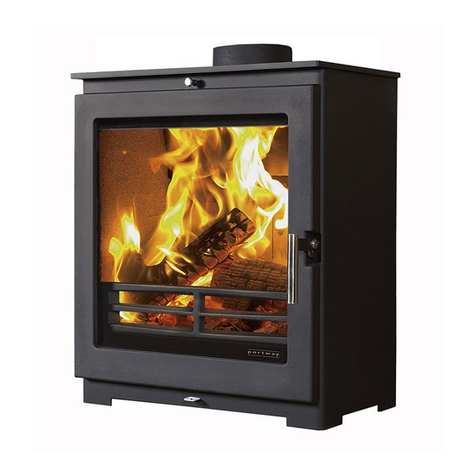
Flavel
Flavel Arundel XL MK2 User manual
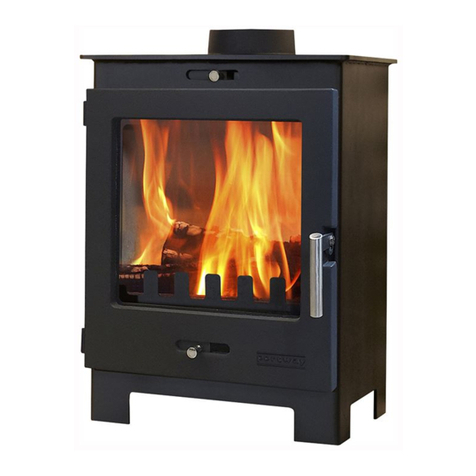
Flavel
Flavel Arundel MK3 User manual
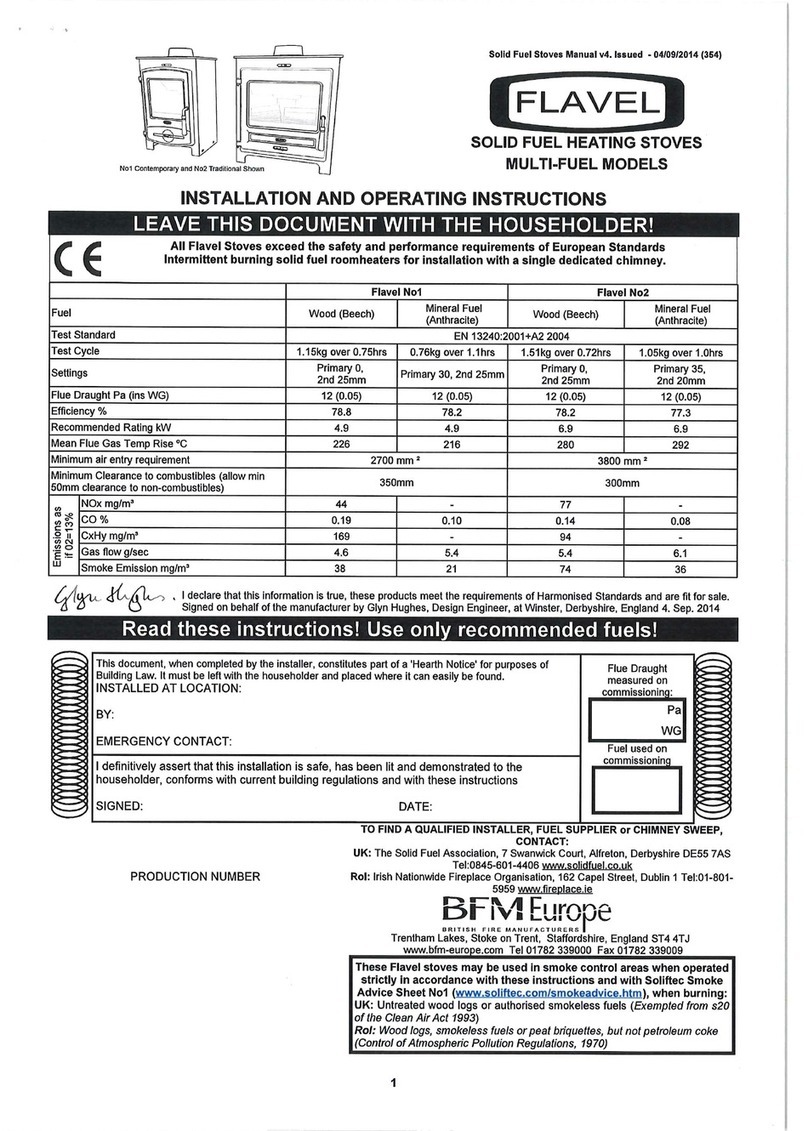
Flavel
Flavel No1 User manual

Flavel
Flavel Rochester 5kW User manual
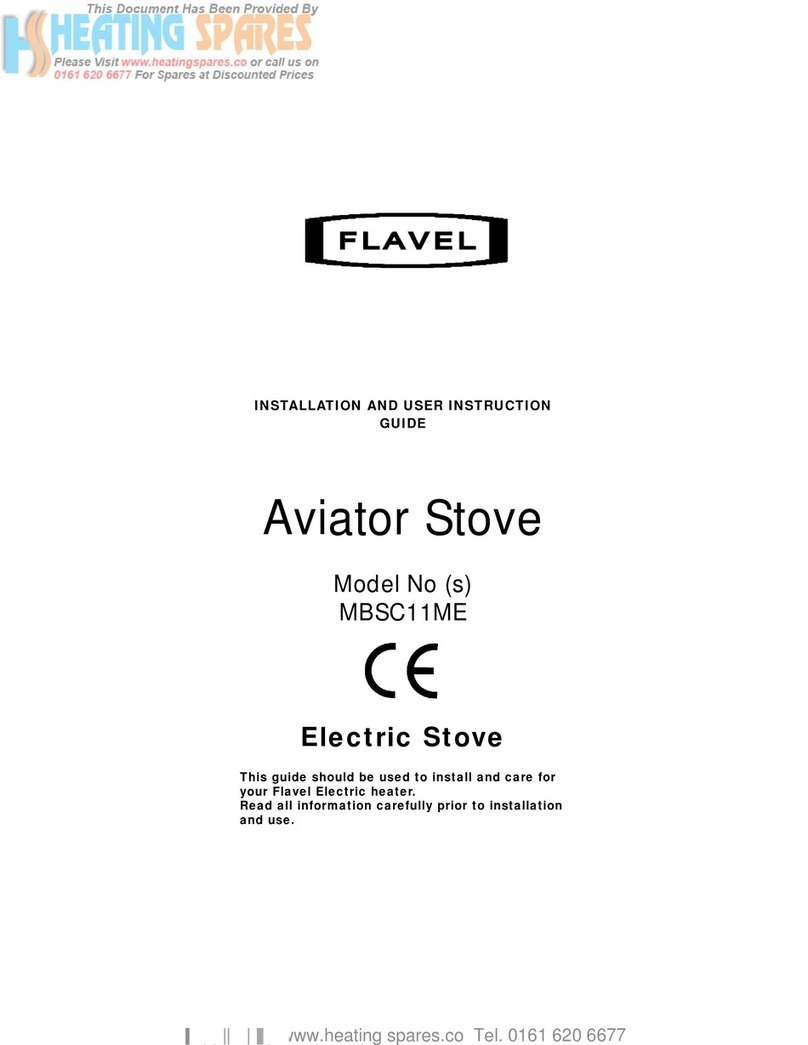
Flavel
Flavel MBSC11ME User manual
Popular Stove manuals by other brands

Enviro
Enviro 50-1386 Technical manual

IDEAL INOX
IDEAL INOX 1510-OCK user manual

Lennox Hearth Products
Lennox Hearth Products Montage 32FS Installation and operation manual
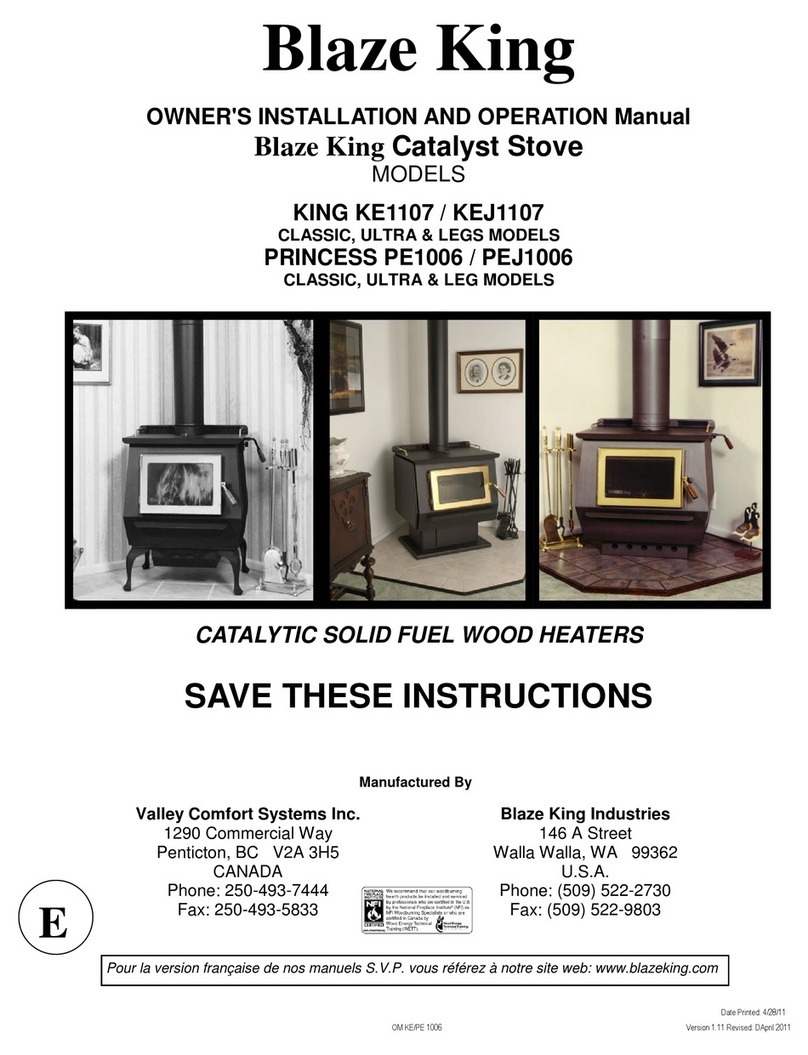
Blaze King
Blaze King KING KEJ1107 Owner's installation and operation manual

Prem-I-Air
Prem-I-Air EH1432 instructions
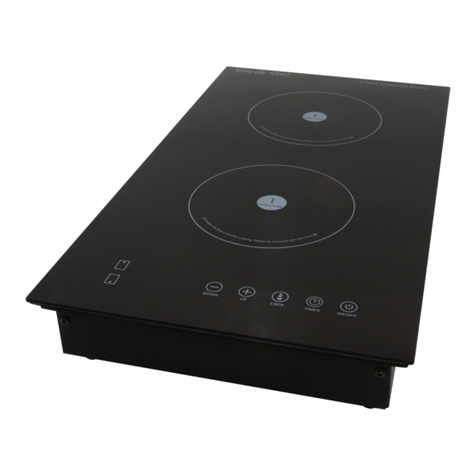
Snappy Chef
Snappy Chef SCD003 user manual

